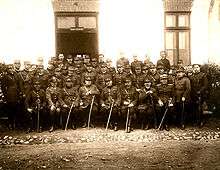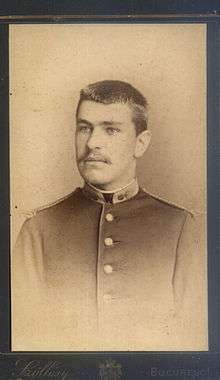Aristide Razu

Divisional General Aristide Razu, CB, (1868–1950) was Commander of the 22nd Romanian Infantry Division in the 1916 Romanian Campaign against the Central Powers,[1] and of the 5th Romanian Infantry Division during the Battle of Mărăşeşti (6–19 August 1917), in World War I. He had been appointed by George V as Honorary Companion of the Military Division of the Most Honourable Order of the Bath on 30 September 1920, when he was Divisional General, Commander of the 1st Army Corps (Comandantul Corpului 1 Armata). Upon his retirement in 1928, he was Divisional General, Inspector, Commander of Geniu (Engineers), of the Communication and Signalling Regiment.
Life and military career
| Battle of Bran-Câmpulung | |||||||
|---|---|---|---|---|---|---|---|
| Part of Romanian Campaign (World War I) | |||||||
| |||||||
| Belligerents | |||||||
|
|
| ||||||
| Commanders and leaders | |||||||
|
|
| ||||||
| Strength | |||||||
|
22nd Infantry Division 12th Infantry Division |
76th Reserve Infantry Division 8th Austro-Hungarian Mountain Brigade | ||||||
| Casualties and losses | |||||||
| Unknown | Unknown | ||||||
Razu was born on 7 March 1868 in the city of Cahul, as Aristarh (Aristide) Razu, to Dr. Aristide Razu and Clara Razu, and baptized in the Orthodox religion. He finished his studies at the University of Liège on 18 October 1895 with a degree in electrical engineering.[2] After joining the army, on 15 June 1902, he married Margareta Laura Zoe Mandrea, daughter of Nicolae and Zoe Mandrea, who was the daughter of Nicolae Balcescu and the niece of Costache Aman, half-brother of the painter Theodor Aman.

He was awarded the "Ordinul Coroana Romaniei cu Spade, gradul de Comandor" (Order of the Romanian Crown with Spades with the rank of Commander), with the ribbon "Virtutea Militara" (Military Virtue) 23 May 1918, for the bravery and vigour with which he led the 5th Romanian Infantry Division on the field of battle. He was awarded the "Steaua Romaniei cu spade in gradul de Comandor" (Order of the Star of Romania with Spades, with the rank of Commander) on 28 July 1918.[3]
He retired in 1928.
Nationalization of properties
In 1932, the Romanian Government declared that underground resources such as oil were to be treated as property of the state,just when General Aristide Razu retired now, was trying to obtain authorization for three oil drilling pumps, on his Land Glodosu in Birsanesti Village, Bacău County Romania, after useless trials against the Romanian Government of that time.
In 1946, various properties belonging to Aristide Razu and members of his family were nationalized:
- In Arges County now Vilcea County, Muzeul Nicolae Balcescu (Land Balcesti -Giltofani) http://www.panoramio.com/photo/34931486[] and http://www.panoramio.com/photo/43354462, belonging to Radu Mandrea, brother of Margareta Razu wife of General Aristide Razu, born from Zoe Balcescu (niece of Nicolae Balcescu by his brother Barbu Balcescu) and Nicolae Mandrea,still nationalized today since 1948.
- In Birsanesti Village, Bacău County, 99 ha of land belonging to General Aristide Razu, Glodosu Land (Mosia Glodosu) https://web.archive.org/web/20090426030621/http://www.panoramio.com:80/photo/17168523 and Seuca/Sauca Land(Mosia Seuca)in Helegiu Village, Bacău County; they even threw out of their graves his parents Dr. Aristide Razu and Clara Razu (born Crupensky) on the land donated by Dr. Aristide Razu to Birsanesti Village for a cemetery, of 1 ha of land; still nationalized today,together with the buildings on 1 ha of land.
- In Osmancea villages, Ciobanita http://www.panoramio.com/photo/27821431, Mereni, Amzacea, Cobadin former Osmancea Village, Constanţa County, 240 Ha of land belonging to his wife Margareta Razu( 202 Ha, still nationalized today) http://www.panoramio.com/photo/40030999[] together with all buildings in Ciobanita Village on 5 Ha of land http://www.panoramio.com/photo/40030984[] http://www.panoramio.com/photo/27435487, the place for grapes growing, in total 900 ha in this particular place as there were three sisters, Margareta Razu, Maria Mandrea and Tea Crasnaru, also called the Agemler Land, including his house on Varsovia Street No. 5, Sector 1 Bucharest. http://www.panoramio.com/photo/17074086[]
Death
He died in 1950 at his grandfather in law's house, Nicolae Mandrea (first president of the Cassation Court of Bucharest), half nationalized as well, on Iulia Hasdeu Street No.11, Bucharest. He has been buried in family chapel, Mandrea Family, at Bellu Cemetery in Bucharest.
References
- ↑ Achim, Irina (2001). Istoria românilor (in Romanian). Editura Enciclopedică. p. 426. ISBN 973-45-0381-2. Retrieved 2010-06-27.
- ↑ H. T. Montague Bell (1927). The Near East year book and who's who: a survey of the affairs, political, economic and social, of Yugoslavia, Roumania, Bulgaria, Greece and Turkey. Near East, Ltd. p. 921. Retrieved 2010-06-27.
- ↑ Ministry of National Defense of Romania; 29 September 1936
External links
- Translation of an account of the Battle of Marasesti
- Photo gallery of contemporary pictures of the Battle of Marasesti
- Photo gallery of Aristide Razu's nationalized properties in Romania
- Photo gallery of the Mondial War/Great War in Romania